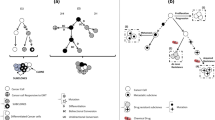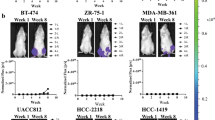Abstract
Cancer metastasis is the main cause of death in various types of cancer. However, in the field of pharmacometrics, cancer disease progression models focus on the growth of primary tumors with tumor volume or weight as target values, while the metastasis process is less mentioned. We propose a series of mathematical models to quantitatively describe and predict the disease progression of 4T1 breast cancer in the aspect of primary breast tumor, lung metastasis and white blood cell. The 4T1 cells were injected into breast fat pad of female BALB/c mice to establish an animal model of breast cancer metastasis. The number and volume of lung metastases at different times were measured. Based on the above data, a disease progression model of breast cancer lung metastasis was established and parameter values were estimated. The white blood cell growth and the primary tumor growth of 4T1 mouse are also modeled. The established models can describe the lung metastasis of 4T1 breast cancer in three aspects: (1) the increase in metastasis number; (2) the growth of metastasis volume; (3) metastasis number-size distribution at different time points. Compared with the prior metastasis models based on von Forester equation, our models distinguished the growth rate of primary tumor and metastasis and got parameter values for 4T1 mouse model. And the current models optimized the metastasis number-size distribution model by utilizing logistic function instead of the prior power function. This study provides a comprehensive description of lung metastasis progression for 4T1 breast cancer model, as well as an alternative disease progression model structure for further pharmacodynamics modeling.





Similar content being viewed by others
Abbreviations
- -2LL:
-
-2 Times the maximum likelihood logarithm
- AIC:
-
Akaike's information criteria
- IIV:
-
Inter individual variability
- GOF:
-
Goodness of fit
- IPRED:
-
Individual predictions
- CWRES:
-
Conditional weighted residual
References
Chen W, Zheng R, Baade PD, Zhang S, Zeng H, Bray F, Jemal A, Yu XQ, He J (2015) Cancer statistics in China. CA Cancer J Clin 66:115–132. https://doi.org/10.3322/caac.21338
Peng Z, Wei J, Lu X, Zheng H, Zhong X, Gao W, Chen Y, Jing J (2016) Treatment and survival patterns of Chinese patients diagnosed with breast cancer between 2005 and 2009 in Southwest China. Medicine (Baltimore). https://doi.org/10.1097/MD.0000000000003865
Koch G, Walz A, Lahu G, Schropp J (2009) Modeling of tumor growth and anticancer effects of combination therapy. J Pharmacokinet Pharmacodyn 36:179–197. https://doi.org/10.1007/s10928-009-9117-9
Norton L, Simon R, Brereton HD, Bogden AE (1976) Predicting the course of Gompertzian growth. Nature 264:542. https://doi.org/10.1038/264542a0
Lord BI (1978) Growth kinetics of tumours. Br J Cancer 37:648–649
Norton L (1988) A gompertzian model of human breast cancer growth. Cancer Res 48:7067–7071
Simeoni M (2004) Predictive pharmacokinetic-pharmacodynamic modeling of tumor growth kinetics in xenograft models after administration of anticancer agents. Cancer Res 64:1094–1101. https://doi.org/10.1158/0008-5472.CAN-03-2524
Ait-Oudhia S, Mager DE (2016) Array of translational systems pharmacodynamic models of anti-cancer drugs. J Pharmacokinet Pharmacodyn 43:549–565. https://doi.org/10.1007/s10928-016-9497-6
Khosravan R, Motzer RJ, Fumagalli E, Rini BI (2016) Population pharmacokinetic/pharmacodynamic modeling of sunitinib by dosing schedule in patients with advanced renal cell carcinoma or gastrointestinal stromal tumor. Clin Pharmacokinet 55:1251–1269. https://doi.org/10.1007/s40262-016-0404-5
Shigesada N, Kawasaki K, Takeda Y (1996) Modeling stratified diffusion in biological invasions. Oceanogr Lit Rev 2:168–169
Iwata K, Kawasaki K, Shigesada N (2000) A dynamical model for the growth and size distribution of multiple metastatic tumors. J Theor Biol 203:177–186. https://doi.org/10.1006/jtbi.2000.1075
Baratchart E, Benzekry S, Bikfalvi A, Colin T, Cooley LS, Pineau R, Ribot EJ, Saut O, Souleyreau W (2015) Computational modelling of metastasis development in renal cell carcinoma. PLOS Comput Biol 11:e1004626. https://doi.org/10.1371/journal.pcbi.1004626
Oda T, Miyao N, Takahashi A, Yanase M, Masumori N, Itoh N, Tamakawa M, Tsukamoto T (2001) Growth rates of primary and metastatic lesions of renal cell carcinoma. Int J Urol 8:473–477. https://doi.org/10.1046/j.1442-2042.2001.00353.x
Deryugina EI, Kiosses WB (2017) Intratumoral cancer cell intravasation can occur independent of invasion into the adjacent stroma. Cell Rep 19:601–616. https://doi.org/10.1016/j.celrep.2017.03.064
Liu Y, Cao X (2016) Characteristics and significance of the pre-metastatic niche. Cancer Cell 30:668–681. https://doi.org/10.1016/j.ccell.2016.09.011
Chin AR, Wang SE (2016) Cancer tills the premetastatic field: mechanistic basis and clinical implications. Clin Cancer Res Off J Am Assoc Cancer Res 22:3725–3733. https://doi.org/10.1158/1078-0432.CCR-16-0028
Tao K, Fang M, Alroy J, Sahagian GG (2008) Imagable 4T1 model for the study of late stage breast cancer. BMC Cancer 8:228. https://doi.org/10.1186/1471-2407-8-228
Rashid OM, Nagahashi M, Ramachandran S, Dumur CI, Schaum JC, Yamada A, Aoyagi T, Milstien S, Spiegel S, Takabe K (2013) Is tail vein injection a relevant breast cancer lung metastasis model? J Thorac Dis 5:385–392. https://doi.org/10.3978/j.issn.2072-1439.2013.06.17
Kaur P, Nagaraja GM, Zheng H, Gizachew D, Galukande M, Krishnan S, Asea A (2012) A mouse model for triple-negative breast cancer tumor-initiating cells (TNBC-TICs) exhibits similar aggressive phenotype to the human disease. BMC Cancer 12:120. https://doi.org/10.1186/1471-2407-12-120
Pulaski BA, Ostrand-Rosenberg S (2001) Mouse 4T1 Breast Tumor Model. In: Coligan JE, Bierer BE, Margulies DH, Shevach EM, Strober W (eds) Current protocols in immunology. Wiley, Hoboken
Gao Z-G, Tian L, Hu J, Park I-S, Bae YH (2011) Prevention of metastasis in a 4T1 murine breast cancer model by doxorubicin carried by folate conjugated pH sensitive polymeric micelles. J Controll Release 152:84–89. https://doi.org/10.1016/j.jconrel.2011.01.021
duPre’ SA, Hunter KW (2007) Murine mammary carcinoma 4T1 induces a leukemoid reaction with splenomegaly: association with tumor-derived growth factors. Exp Mol Pathol 82:12–24. https://doi.org/10.1016/j.yexmp.2006.06.007
Kowanetz M, Wu X, Lee J, Tan M, Hagenbeek T, Qu X, Yu L, Ross J, Korsisaari N, Cao T, Bou-Reslan H, Kallop D, Weimer R, Ludlam MJC, Kaminker JS, Modrusan Z, van Bruggen N, Peale FV, Carano R, Meng YG, Ferrara N (2010) Granulocyte-colony stimulating factor promotes lung metastasis through mobilization of Ly6G+Ly6C+ granulocytes. Proc Natl Acad Sci 107:21248–21255. https://doi.org/10.1073/pnas.1015855107
Lin EY, Nguyen AV, Russell RG, Pollard JW (2001) Colony-stimulating factor 1 promotes progression of mammary tumors to malignancy. J Exp Med 193:727–740. https://doi.org/10.1084/jem.193.6.727
Hölzel D, Eckel R, Emeny RT, Engel J (2010) Distant metastases do not metastasize. Cancer Metastasis Rev 29:737–750. https://doi.org/10.1007/s10555-010-9260-1
Tsoularis A, Wallace J (2002) Analysis of logistic growth models. Math Biosci 179:21–55. https://doi.org/10.1016/S0025-5564(02)00096-2
McKendrick AG, Pai MK (1912) XLV. The rate of multiplication of micro-organisms: a mathematical study. Proc R Soc Edinb 31:649–653. https://doi.org/10.1017/S0370164600025426
Liotta LA, Saidel GM, Kleinerman J (1976) Stochastic model of metastases formation. Biometrics 32:535–550. https://doi.org/10.2307/2529743
Fidler IJ (2003) The pathogenesis of cancer metastasis: the “seed and soil” hypothesis revisited. Nat Rev Cancer 3:453–458. https://doi.org/10.1038/nrc1098
Psaila B, Lyden D (2009) The metastatic niche: adapting the foreign soil. Nat Rev Cancer 9:285–293. https://doi.org/10.1038/nrc2621
Kaplan RN, Riba RD, Zacharoulis S, Bramley AH, Vincent L, Costa C, MacDonald DD, Jin DK, Shido K, Kerns SA, Zhu Z, Hicklin D, Wu Y, Port JL, Altorki N, Port ER, Ruggero D, Shmelkov SV, Jensen KK, Rafii S, Lyden D (2005) VEGFR1-positive haematopoietic bone marrow progenitors initiate the pre-metastatic niche. Nature 438:820–827. https://doi.org/10.1038/nature04186
Fazilaty H, Gardaneh M, Bahrami T, Salmaninejad A, Behnam B (2013) Crosstalk between breast cancer stem cells and metastatic niche: emerging molecular metastasis pathway? Tumour Biol J Int Soc Oncodev Biol Med 34:2019–2030. https://doi.org/10.1007/s13277-013-0831-y
Incardona F, Doroudchi MM, Ismail N, Carreno A, Griner E, Anna Lim M, Reproducibility Project: Cancer Biology (2015) Registered report: interactions between cancer stem cells and their niche govern metastatic colonization. eLife. https://doi.org/10.7554/eLife.06938
Huang Y, Song N, Ding Y, Yuan S, Li X, Cai H, Shi H, Luo Y (2009) Pulmonary vascular destabilization in the premetastatic phase facilitates lung metastasis. Cancer Res 69:7529–7537. https://doi.org/10.1158/0008-5472.CAN-08-4382
Onder TT, Gupta PB, Mani SA, Yang J, Lander ES, Weinberg RA (2008) Loss of E-cadherin promotes metastasis via multiple downstream transcriptional pathways. Cancer Res 68:3645–3654. https://doi.org/10.1158/0008-5472.CAN-07-2938
Mani SA, Guo W, Liao M-J, Eaton ENG, Ayyanan A, Zhou AY, Brooks M, Reinhard F, Zhang CC, Shipitsin M, Campbell LL, Polyak K, Brisken C, Yang J, Weinberg RA (2008) The epithelial-mesenchymal transition generates cells with properties of stem cells. Cell 133:704–715. https://doi.org/10.1016/j.cell.2008.03.027
Zheng H, Takahashi H, Murai Y, Cui Z, Nomoto K, Niwa H, Tsuneyama K, Takano Y (2006) Expressions of MMP-2, MMP-9 and VEGF are closely linked to growth, invasion, metastasis and angiogenesis of gastric carcinoma. Anticancer Res 26:3579–3583
Luca M, Huang S, Gershenwald JE, Singh RK, Reich R, Bar-Eli M (1997) Expression of interleukin-8 by human melanoma cells up-regulates MMP-2 activity and increases tumor growth and metastasis. Am J Pathol 151:1105
Acknowledgements
This work was funded by Natural Science Foundation of Beijing Municipality (Grant No. 7192100).
Author information
Authors and Affiliations
Contributions
T-yZ, LY designed research; LY, LY, Y-YF performed experiments; LY, LY, XZ, YF, D-mK, WL performed the mathematical model; LY wrote the paper.
Corresponding author
Ethics declarations
Conflict of interest
The authors declare that they have no conflict of interest.
Ethical approval
All applicable international, national, and/or institutional guidelines for the care and use of animals were followed. All procedures performed in studies involving animals were in accordance with the ethical standards of the Institutional Animal Care and Use Committee of Peking University (LA2018272) at which the studies were conducted.
Additional information
Publisher's Note
Springer Nature remains neutral with regard to jurisdictional claims in published maps and institutional affiliations.
Electronic supplementary material
Below is the link to the electronic supplementary material.
Rights and permissions
About this article
Cite this article
Yang, L., Yong, L., Zhu, X. et al. Disease progression model of 4T1 metastatic breast cancer. J Pharmacokinet Pharmacodyn 47, 105–116 (2020). https://doi.org/10.1007/s10928-020-09673-5
Received:
Accepted:
Published:
Issue Date:
DOI: https://doi.org/10.1007/s10928-020-09673-5




